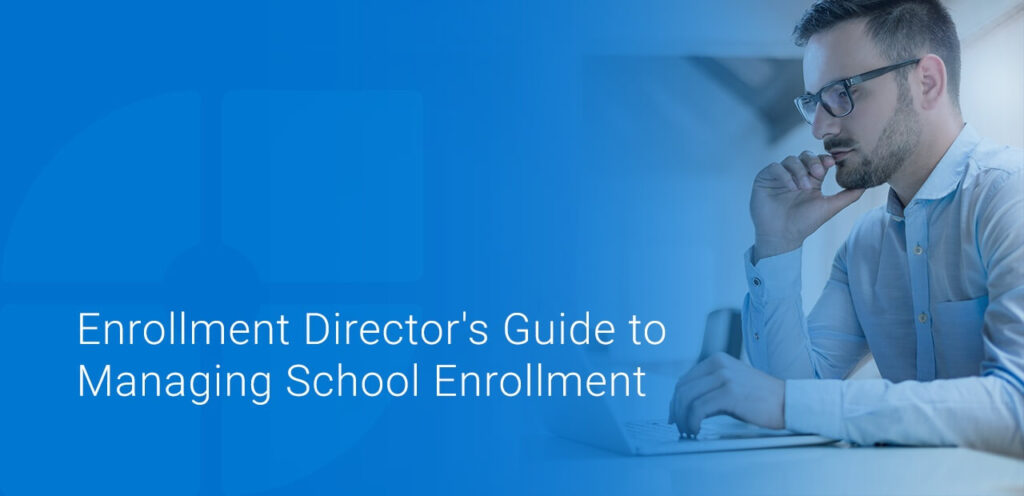A school’s enrollment rates are often indicators of its success. As enrollment rates go up, students and families tend to be happier, and the school’s financial situation improves. By enhancing a school’s recruitment strategy through enrollment management, you can make your school attractive to potential students and families. With the right enrollment management plan, you can boost enrollment numbers, contributing to the school’s overall success. Use this comprehensive private school enrollment management guide for best practices on managing your school’s enrollment strategy.
- What Is Enrollment Management?
- The 4 Pillars of Enrollment Management
- The Importance of Enrollment Management
- The Duties of an Enrollment Director
- Essential Skills for Enrollment Management
- Diversity, Equity and Inclusion in Enrollment
- 9 Valuable Tools for Enrollment Directors
- Consider the Family Experience in Your Strategy
- Explore Enrollment Management Solutions
What Is Enrollment Management?
Enrollment management is a strategic method for shaping a school’s student body. More than simply recruiting as many students as possible, enrollment management methods include establishing informed tactics and making goal-oriented enrollment decisions. An effective enrollment management strategy can help foster student success while maintaining a school’s financial situation and public reputation.
To promote the growth of the student body, an enrollment director can implement strategies like marketing campaigns, academic aid programs for retention, and scholarships or other financial aid packages. An enrollment management strategy can evolve as the director discovers specific campaigns work exceptionally well. The director can then decide to expand successful campaigns.
The 4 Pillars of Enrollment Management
An enrollment director must focus on several enrollment areas at once to promote school development. Here are the four elements of a strategic enrollment management strategy:
1. Reaching Out
Before a family can consider a school as an option, they must first become aware of the school. Marketing is essential for promoting your school’s strengths and showing candidates how the programs offered can help students achieve their goals. The more your school’s ideals and offerings match the interests and needs of the family, the more likely they are to consider your organization. With targeted marketing campaigns, you can ensure your school’s message reaches those who are most likely to apply.
2. Recruitment
After the first contact, the next step is to help the family see the merits of enrolling in your private or K-12 school. In this critical phase, allowing the family to participate in student life or introductory courses can help them feel like they’re already part of the school culture. From initial application forms to financial aid services, your recruitment process should be straightforward so your prospects will want to follow through with it.
3. Retention
After recruitment, the enrollment director should verify that families find fulfillment in the school and want to stay through future admission periods. For students, this involves identifying those struggling with coursework and providing them with accommodations to help them excel. It can also mean ensuring students have ample opportunities for enrichment through clubs and extracurricular activities. It’s essential to nurture family relationships with the school and keep them engaged in student affairs so they continue to see the value in enrolling their child.
4. Research
By collecting historical enrollment data, you can gradually build a clearer picture of the factors contributing to a happier and fuller student body. These analytics can also help you identify areas of improvement in your enrollment strategy. Frequently conducting research confirms your enrollment management strategy can adapt to any changes in enrollment trends.
The Importance of Enrollment Management
Enrollment is the core pillar of any school, and enrollment management offers many benefits in addition to increased enrollment rates. Here are some of the most significant benefits of enrollment management:
- School spirit: When the community invests in the success and continued growth of the school, everyone benefits. You can achieve school spirit by creating an environment where students, parents, staff, and alumni can all engage with the school in their own ways. As more people fall in love with the school, the community becomes a marketing campaign of its own. Satisfied parents and alumni will be more likely to encourage their friends to enroll. Similarly, donors may give more generously if you give them opportunities to actively see the fruits of their donations.
- Financial success: Although many schools can pay a generous chunk of their operating expenses through donor generosity, most of a school’s budget comes from student tuition. With more students comes a higher budget, which can help you reach even higher enrollment and revenue goals by steadily improving aspects of the school.
- Improved planning: The data gathered by an enrollment management plan is valuable for more than increasing enrollment numbers. You can use it to inform many other decisions, like creating financial aid packages and deciding on tuition levels. You can also use it to gauge overall school satisfaction and find ways to make your school an even better place to learn.
The Duties of an Enrollment Director
The enrollment director is responsible for the continued growth of the student body. Here are some of the core duties of an enrollment director:
- Developing an enrollment plan: The director’s primary responsibility is to ensure enrollment numbers satisfy the school’s enrollment goals and promote financial stability.
- Managing offices and committees: The enrollment director oversees the operations of the admissions and financial aid offices. They’re also responsible for organizing admission committees and choosing who should take part in them.
- Public speaking: The director can utilize public forums to speak on behalf of the school and inform people of the opportunities available to students. Similarly, the director will need to make regular presentations to trustees regarding school enrollment rates. They also attend all board meetings and serve on several trustee subcommittees to certify they consider the needs of the admissions department in discussions.
- Budgeting: The director manages the school’s financial aid budget and makes sure the school uses the funds effectively to increase school enrollment rates. The director must also consider the decisions of the chief financial officer, the board, and the head of the school when using budgeted resources.
Essential Skills for Enrollment Management
With so many responsibilities comes a need for specialized skills. An enrollment director can enjoy greater rates of success by honing these essential management skills:
- Process management: Properly executing an enrollment management strategy requires long-term planning skills and the ability to change directions if a process needs to be improved quickly.
- Marketing: An enrollment manager would benefit from a solid understanding of marketing strategies. From launching social media campaigns to distributing flyers and mailing letters, implementing the best strategies for outreach is essential for finding new students.
- Data analysis: By analyzing enrollment data, you can further focus your school’s enrollment goals by tweaking areas where the data indicates change would be helpful. You can also present data to administrators and other stakeholders to show them the progress toward those goals.
- Technology: In addition to being comfortable with data analysis software, an enrollment director should be prepared to work with and introduce new technology. Tools to improve business processes are constantly evolving, and a flexible enrollment director can usher in smart solutions to expedite existing processes.
- Communication: Strong written and oral communication skills allow an enrollment director to collaborate with other departments and develop more effective enrollment strategies. Communication skills also help to highlight the school’s strengths to students and families during presentations. Remember that when reaching out to the community to help promote the school, it’s essential to speak confidently about its merits.
Diversity, Equity and Inclusion in Enrollment
Diversity, equity and inclusion (DEI) play an essential role in your school’s enrollment process. Students all come from unique and diverse backgrounds, meaning that the student and family experience might look different from home to home. When you want to better manage your enrollment solution with these factors involved, you can integrate various strategies, including:
- Understanding the role of diversity and inclusion in enrollment: Understanding how your students might encounter diversity, equity and inclusion throughout your enrollment process can help strengthen your enrollment rates and management practices. DEI protects each student’s ability to apply and enroll in your institution. Students might need tools, resources or assistance to complete the enrollment process efficiently. For example, students from multilingual families might need to complete enrollment with language services or translations.
- Addressing inequity in education accessibility: Educational accessibility is a challenge that impacts many families in public and private institutions. Inequitable systems and schools lack the support and resources students and families need to access the same services and education level as other students. For example, blind students need text readers to navigate online systems. By addressing the inequities preventing access to your school through enrollment and other systems, you can make your school more accessible to all students seeking a private school education.
- Implementing processes and initiatives to increase opportunities: As you approach enrollment season, you can integrate new processes and tactics to create more inclusive and equitable enrollment processes for students. For example, you might offer more comprehensive financial aid and scholarships to assist students and families who lack the funds to access private school education. Creating more opportunities to help students can boost fairness in your enrollment process.
DEI initiatives and programs can greatly benefit your private school. With a more diverse student population, students can better develop their empathy and world views to reflect more backgrounds. By starting with the enrollment process, you can foster more positive relationships with families and students, showing you have the tools and resources to support their needs.
9 Valuable Tools for Enrollment Directors
While manual methods for organizing enrollment data may have worked well in the past, new digital tools now exist to help improve the process. Knowing what enrollment management strategies and features can support your school and students can strengthen your enrollment technology investments.
1. Family-Friendly Platform
One of the most tedious parts of applying to schools is creating individual logins for each application. Every new school application requires parents to keep track of another set of login information, creating increased chances of lost credentials. Admission management software removes that barrier entirely by allowing families to apply to multiple schools within a single easy-to-use platform. Parents can easily submit forms and monitor application statuses in one place, making the entire admissions process much more pleasant.
2. Personalized Admissions Experience
When a family considers multiple schools, it’s essential to make your application process stand out from the rest. You can personalize applications made within your admission management software with custom images, colors and more. That way, the merits of your school can shine through even while the family fills out their application.
3. Automated Workflow
Your admission management software allows you to automate many tasks and save time. You can automatically flag applications for future reference, assign specific readers and send personalized email campaigns to families.
4. Simplified Interviews
Scheduling interviews through traditional methods can take up time better spent conducting interviews. With online scheduling tools, you can share schedules and availability with applicants and automate scheduling entirely.
5. Expedited Application Processing
When you have a high volume of applications, individually processing each one can be time-consuming. Fortunately, admission management software can help by housing documents electronically and allowing for high-volume document processing.
6. Easy Access
In the past, reviewing applications meant downloading PDFs or printing individual forms from every applicant for review. Reviewing applications can be confusing with a high volume of applicants, and organizing your files can take up a large chunk of time. With admission management software, all application data is available within the program and is accessible any time you need it. You can even allow multiple users to access files simultaneously, allowing for a thorough and collaborative review within a larger committee.
7. Empowered Family Interactions
With so many prospective applicants, it can be challenging to keep track of their needs and communication preferences. Thankfully, your admission management software can help by tracking individual applicants throughout the process. You can use engagement tracking tools to see how families have interacted with applications and other communications, which helps to inform the best ways to reach out to them.
8. Student Information Systems and Customer Relationship Management Software
Many enrollment solutions can integrate with student information systems (SIS) and customer relationship management (CRM) software. Both solutions can help enrollment directors and teams manage enrollment and better serve your incoming students and families.
SIS integrates information, like attendance records and grades, so you can assess student performance to enroll them in the classes that will match their academic level. Some electives and core classes might require prerequisites to enroll, so integrated SIS can ensure students have all the credits they need before they register for advanced courses.
CRM solutions collect interaction data and store them in one place for better organization and understanding. By integrating your CRM with your enrollment solution, you can discover where families get stuck to offer better assistance in the next season. If families abandon the enrollment process, you can target those sections to strengthen them or intervene when students reach that point.
9. Forecasting and Predictive Analytics
Some of the enrollment management best practices involve using predictive analytics to forecast student and family behavior. Predictive features and data allow enrollment directors and their teams to act proactively rather than reactively, addressing problems before they even arise. This feature works by pulling from historical data, trends, and demographics to understand student and family behavior during enrollment.
For example, your trends and historical data might reveal that most families abandon the enrollment process upon reaching a certain step. By highlighting this problem, your staff can develop stronger communication strategies, like reminders and alerts, and services to target the root of the problem and keep families engaged throughout enrollment.
Consider the Family Experience in Your Strategy
One of the most critical parts of an enrollment management strategy is appealing to parents so they feel motivated to apply. Today’s parents want their children to have a new type of education that uses innovative teaching methods and motivates thoughtful class discussions.
Alongside academic growth, parents want their children to learn skills that will help them in the workforce and beyond. From emotional development to learning about civic duty, they want to prepare their kids to shape the world. Demonstrating that your school can meet parents’ expectations goes a long way in convincing them to apply. Here are some ideas to warrant that families have a positive and unique enrollment experience:
- Offer class visits: Provide opportunities for potential students and their families to visit classes before filling out enrollment forms. Classroom visits are an excellent way for students to interact with teachers and current students, giving them a feel for what it’s like to be a student at your school.
- Maintain communication: Send frequent updates to families through email blasts and texts. Include information about school events and activities — and even invite them to the events directly. You can also send photos and videos highlighting student life to keep the positive image of the school at the front of their minds.
- Host informational meetings: Coordinate informational days where parents can get to know the faculty and ask questions about academic programs, extracurricular activities, and admissions. Also, consider pairing prospective parents with parents currently enrolling their children to reinforce the school’s best qualities.
- Conduct tours: Invite families to on-site tours during class hours so they can get a full view of the school experience.
- Make applying easy: Make the application process easy for families by providing them with an easy-to-use online platform that shows them all the steps they need to finish before they complete their application.
- Provide various payment plans: Allow for flexible tuition payment plan options so parents can pay in the way that works for them.
- Make applications universal: Create a diverse and inclusive school environment by identifying areas in your application process that might discourage particular groups from applying and simplifying them.
Explore Enrollment Management Solutions
With the power of an enrollment management suite, an enrollment director can automate tasks that typically take hours and instead use that time to plan and set goals. In fact, the average school can save up to 500 hours on manual tasks during their first year using an enrollment management solution. With powerful tools like contract management, billing software, and financial aid integration, you can enhance other aspects of your school’s administrative processes.
Education Brands offers enrollment management software for private and independent K-12 schools that can be paired with Ravenna. We’ve developed our software with the family experience in mind, simplifying the process so parents have an excellent enrollment experience from first contact to first tuition payment.
Contact us today if you have any questions or would like to request a demo of how you can streamline processes from admissions to enrollment.



